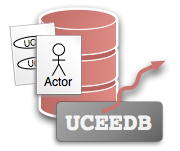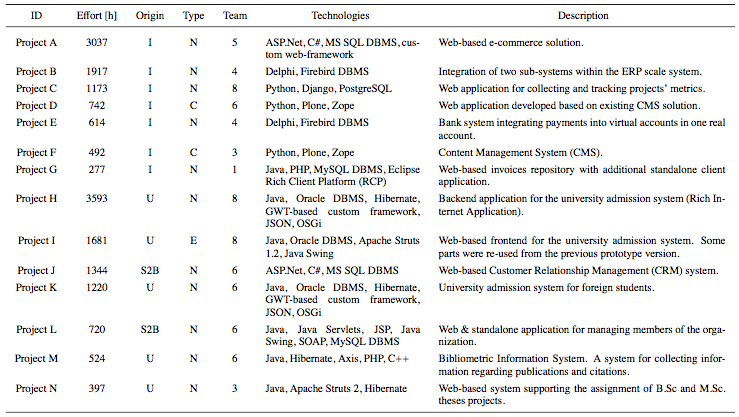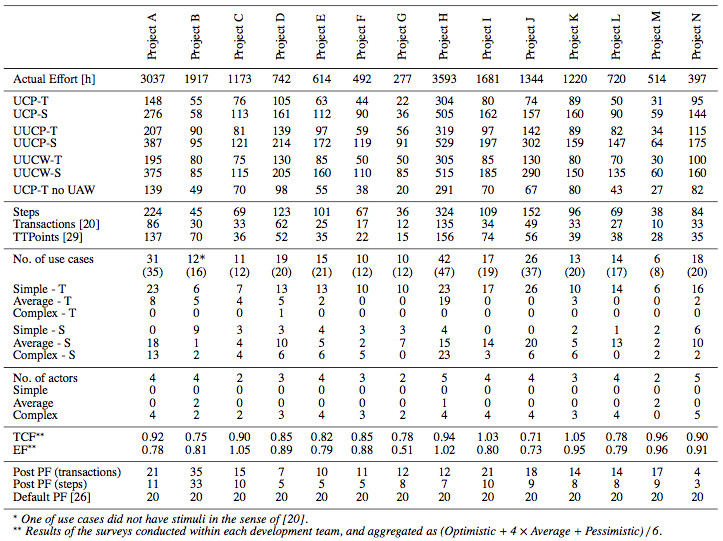Use-case-based effort estimation database (UCEEDB)
The goal of the UCEEDB

Thank to use-case-based effort estimation database (UCEEDB) you can:
- calibrate Use Case Points method [1],
- find similar projects to yours in order to derive effort estimation models that relay on use-case-based functional size measures as Transactions [2] or TTPoints [3, 4].
Projects in the database
The database contains data from 14 projects that were developed in Poland either by software development companies or at the Poznan University of Technology.
In Table 1, one can find description of the projects including recorded effort and some information regarding their contexts. The detailed measures regarding use-case-based functional size measures are presented in Table 2. It contains calculations of Use Case Points based on the number of steps and transactions (calculated according to [2]), Transactions [2], and TTPoints [3, 4].
Table 1 Application domain and basic description of the projects under study. Origin: I – project developed by a software development company; U – projects developed by university staff and students for the internal usage at the university; S2B – project developed by students for external organizations. Type: N – application was developed from scratch; C – application was based on existing solution and was tailored for the customer; E – major enhancement, i.e., strongly simplified version was available (e.g. a prototype).
Table 2 Projects characteristics (T – transactions, identified using stimuli-verb approach proposed by Robiolo and Orosco [20]; S – steps without reference to other use cases – include and extend relations; number of use cases before the review of the specifications are placed in brackets)
How to cite?
The database of the projects was published in the paper [4]:
M. Ochodek, J. Nawrocki, and K. Kwarciak. Simplifying effort estimation based on Use Case Points. Information and Software Technology, 53(3):200–213, 2011.
Bibtex entry:
@article{Ochodek2010ist,
Author = {M. Ochodek and J. Nawrocki and K. Kwarciak},
Doi = {DOI: 10.1016/j.infsof.2010.10.005},
Issn = {0950-5849},
Journal = {Information and Software Technology},
Number = {3},
Pages = {200--213},
Title = {{Simplifying effort estimation based on Use Case Points}},
Url = {http://www.sciencedirect.com/science/article/B6V0B-51B1WMT-1/2/022008b3eaefc46465eea3e3e17835a3},
Volume = {53},
Year = {2011},
Bdsk-Url-1 = {http://www.sciencedirect.com/science/article/B6V0B-51B1WMT-1/2/022008b3eaefc46465eea3e3e17835a3},
Bdsk-Url-2 = {http://dx.doi.org/10.1016/j.infsof.2010.10.005}}
References
- G. Karner. Metrics for objectory. No. LiTH-IDA-Ex-9344:21. Master’s thesis, University of Linkoping, Sweden, 1993.
- G. Robiolo and R. Orosco. Employing use cases to early estimate effort with simpler metrics. Innovations in Systems and Software Engineering, 4(1):31–43, 2008.
- M. Ochodek and J. Nawrocki. Enhancing use-case-based effort estimation with transaction types. Foun- dations of Computing and Decision Sciences, 35(2):91–106, 2010.
- M. Ochodek, J. Nawrocki, and K. Kwarciak. Simplifying effort estimation based on Use Case Points. Information and Software Technology, 53(3):200–213, 2011.






